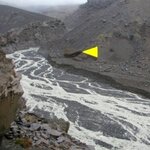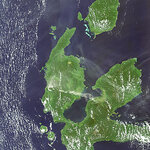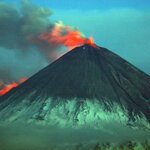Geology

Pressures and temperatures at the Earth’s core are stupendous – more than 3.5 Mbar and 7000K – and currently it is impossible to recreate these conditions in the laboratory. Our information about the core comes from observing the way that seismic waves travel through the core, extrapolating from experimental studies and studying iron rich meteorites.
As a result we know that the core is mostly iron, but that it also must contain some light impurities such as oxygen, silicon, sulphur, hydrogen and magnesium (because the density of the core is too low to be pure iron). The most significant…

Permafrost, the perpetually frozen foundation of the north, serves like a platform underneath vast expanses of northern forests and wetlands that are rooted in many northern ecosystems. But rising atmospheric temperatures are accelerating rates of permafrost thaw in northern regions, says MSU researcher Merritt Turetsky.
“The loss of permafrost usually means the loss of terra firma in an otherwise often boggy landscape,” Turetsky said. “Roads, buildings and whole communities will have to cope with this aspect of climate change. What this means for ecosystems and humans residing in the North…

The DNA of ancient microorganisms, long frozen in glaciers, may return to life as the glaciers melt, according to a paper published online this week in the Proceedings of the National Academy of Sciences by scientists at Rutgers and Boston University.
The finding is significant, said Kay Bidle, assistant professor of marine and coastal sciences at Rutgers, because scientists didn’t know until now whether such ancient, frozen organisms and their DNA could be revived at all or for how long cells are viable after they’ve been frozen.
Bidle and his co-authors, Rutgers colleague Paul Falkowski,…

A new substance analyzer has been developed by the All-Russian Scientific Research Institute of Technical Physics and Automation in Moscow.
Its functionality is to automatically determine the content of up to 20 chemical elements in the periodic table between calcium and bismuth but in a package small enough to fit in a rucksack.
Basically it runs an X-ray generator over the surface of the core, stimulating all atoms of the specimen within a radius of slightly less than 2 centimeters. It will then independently measure “secondary” fluorescent radiation: the atoms stimulated by X-ray, when…

If you've never heard of Lake Agassiz, it's no surprise. It disappeared over 8,000 years ago. Yet it may have been the global warming trigger that ended the last Ice Age.
Using remains from lakes, bogs and channels, a multi-disciplinary group of scientists recently tackled the secrets of glacial Lake Agassiz and Big Stone Moraine.
Knowing the chronology of glacier retreat, and when glacial lakes formed, is important in linking physical events on the landscape with paleoclimate records. At the close of the last ice age, glacial ice in the upper Midwest of the United States retreated very…

Volcanologist Sarah Fagents from the University of Hawaii at Manoa had an amazing opportunity to study volcanic hazards first hand, when a volcanic mudflow broke through the banks of a volcanic lake at Mount Ruapehu in New Zealand.
Fagents and colleagues were there on a National Science Foundation (NSF)-funded project to study the long-forecast Crater Lake break-out lahar at Mount Ruapehu. A lahar is a type of mudflow composed of water and other sediment that flows down from a volcano, typically along a river valley.
Lahars are caused by the rapid melting of snow and/or glaciers during a…

Indonesia’s Mount Gamkonora volcano is spewing hot ash and smoke into the air, as seen in this image taken by the MERIS instrument aboard ESA’s satellite Envisat, causing more than 8000 people to be evacuated amid fears of an imminent eruption, according to officials.
Officials raised the alert to the highest level on Tuesday after the volcano, located in the eastern province of North Maluku, started spitting out flaming material, indicating magma was approaching the crater’s surface making an eruption more likely, Saut Simatupang of Indonesia's Vulcanological Survey told Reuters news agency…

Klyuchevskoy (pronounced Kloo-shef-skoy), a stratovolcano located in the north central region of the Kamchatka Peninsula, is blasting ash up to 32,000 feet in the air, and has diverted air traffic headed toward the Far East.
This is the largest eruption to occur in the North Pacific in a decade, and is providing students at the University of Alaska Fairbanks a unique opportunity to collaborate with scientists, as well as state and federal agencies.
Klyuchevskoy’s been erupting since January, but the largest explosions in the eruption began June 28, 2007.
These explosions created a 1,360-…

Geodesists from the University of Bonn have remeasured the size of the Earth in a long lasting international cooperation project.
The blue planet is accordingly some millimeters smaller than up to now assumed. The results are important, for example, to be able to demonstrate a climate contingent rise in sea level.
The system of measurement used by the Bonn Geodesists is invisible. It consists of radiowaves that are transmitted into space from punctiform sources, the so-called Quasars. A network of more than 70 radio telescopes worldwide receives these waves. Because the gaging stations are…

Laboratory measurements of a high-pressure mineral believed to exist deep within the Earth show that the mineral may not, as geophysicists hoped, have the right properties to explain a mysterious layer lying just above the planet’s core.
A team of scientists, led by Sébastien Merkel, of the University of California, Berkeley, made the first laboratory study of the deformation properties of a high-pressure silicate mineral named post-perovskite.
"This the first time the deformation properties of this mineral have been studied at lower mantle temperatures and pressures," says Allen McNamara of…